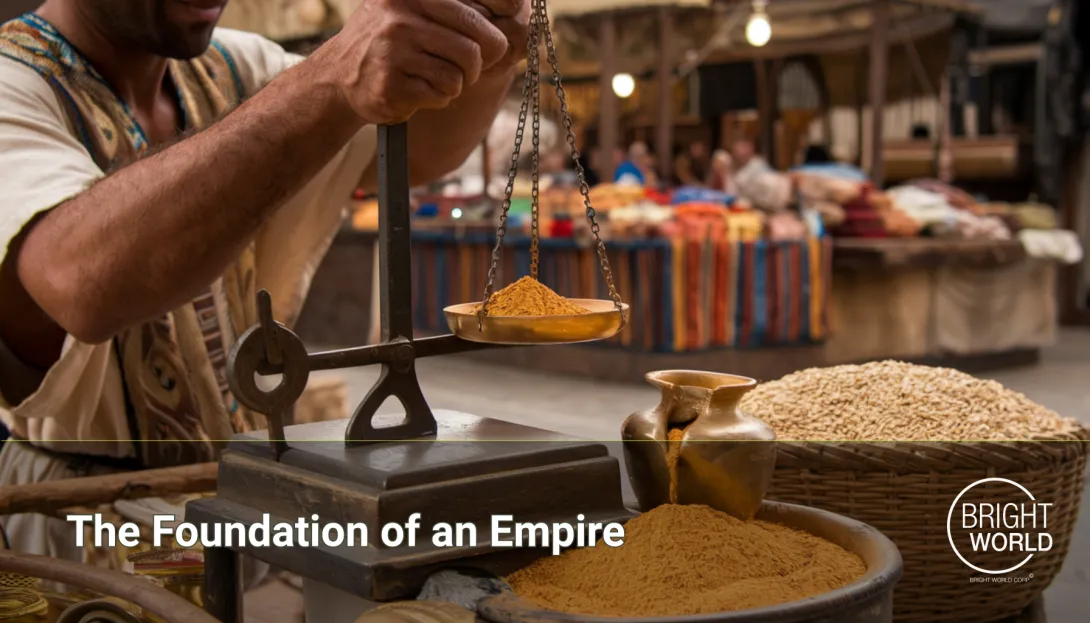
The economic system of ancient Egypt, one of history's most enduring civilizations spanning over three millennia, was fundamentally shaped by trade and complex systems of value exchange. While Egypt's legacy often emphasizes its architectural marvels and cultural achievements, its true strength lay in its sophisticated economic infrastructure, which evolved through the Old, Middle, and New Kingdoms (c. 2686 BCE - 1069 BCE).
The Geographical Foundation of Egyptian Trade
Egypt's strategic position—nestled between the Mediterranean and Red Seas, with the life-giving Nile flowing through its heart—established it as a natural nexus of ancient commerce. This geographical advantage created a natural corridor connecting sub-Saharan Africa, the Near East, and the Mediterranean world, facilitating trade routes that would endure for millennia.
Egyptian Trade: Beyond Simple Commerce
Trade in ancient Egypt transcended mere commercial exchange, forming an intricate web of diplomatic, cultural, and economic relationships. Egyptian merchants traded not only tangible goods but also participated in a complex system of gift exchange with foreign rulers, a practice well-documented in the Amarna letters (14th century BCE). The primary exports included:
Gold from Nubian mines (particularly during the New Kingdom)
Papyrus, a writing material that became synonymous with Egyptian culture
Fine linen, produced from Egyptian cotton and prized throughout the ancient world
Grain, leveraging the Nile's agricultural bounty
In return, Egypt imported:
Cedar from Lebanon (essential for shipbuilding and luxury items)
Lapis lazuli from Afghanistan (via intermediate traders)
Copper and turquoise from Sinai
Exotic goods from Punt, including myrrh, frankincense, and rare animals
The Evolution of Egyptian Currency
The article's discussion of currency requires important chronological clarification. The Egyptian economy operated through multiple phases:
Early Dynastic to Old Kingdom (c. 3150-2181 BCE): Relied primarily on barter and standardized commodity exchange
Middle Kingdom to Late Period (c. 2055-332 BCE): Developed the sophisticated deben system
Late Period onwards (525 BCE): Gradual integration of coined money, initially through foreign currency
The deben system deserves more precise explanation: it was not simply a weight measurement but a sophisticated value standard. One deben equaled approximately 91 grams of copper or precious metal, and it was subdivided into smaller units called qite (1/10 of a deben). This system remained remarkably stable for over a millennium.
Administrative Control and Economic Organization
The pharaonic administration maintained elaborate records of transactions, inventories, and tax collections, documented in hieratic script on papyri. The most detailed evidence comes from:
The Wilbour Papyrus (c. 1150 BCE), recording land assessments and taxation
The Heqanakht papers (c. 2000 BCE), providing insight into private economic transactions
Various temple accounts, particularly from the Ramesside period
International Impact and Legacy
The article's discussion of Egypt's international influence can be expanded. Archaeological evidence from Minoan Crete, Mycenaean Greece, and the Levantine coast demonstrates the far-reaching impact of Egyptian economic practices. The standardization of weights and measures, sophisticated accounting practices, and the development of economic bureaucracy influenced subsequent civilizations throughout the Mediterranean basin.
Grammatical and Stylistic Improvements
The original text would benefit from:
More precise temporal markers to distinguish between different periods
Clearer transitions between topics
More specific terminology regarding economic practices
Integration of primary source references
Reduction of passive voice constructions
More nuanced discussion of the relationship between political and economic power
Adapting Over Millennia
Ancient Egypt's economic system demonstrated remarkable sophistication and stability, adapting over millennia while maintaining core principles of centralized control and standardized exchange. Its influence extended far beyond its temporal and geographical boundaries, contributing significantly to the development of economic systems throughout the ancient Mediterranean world.